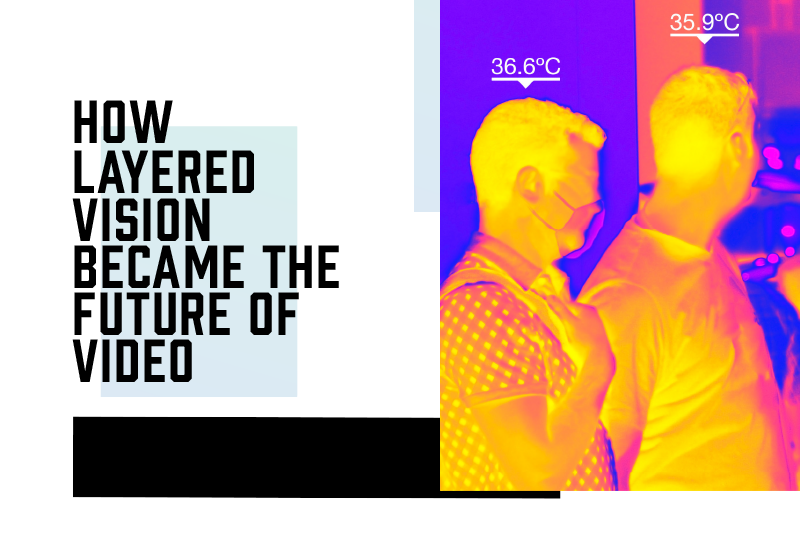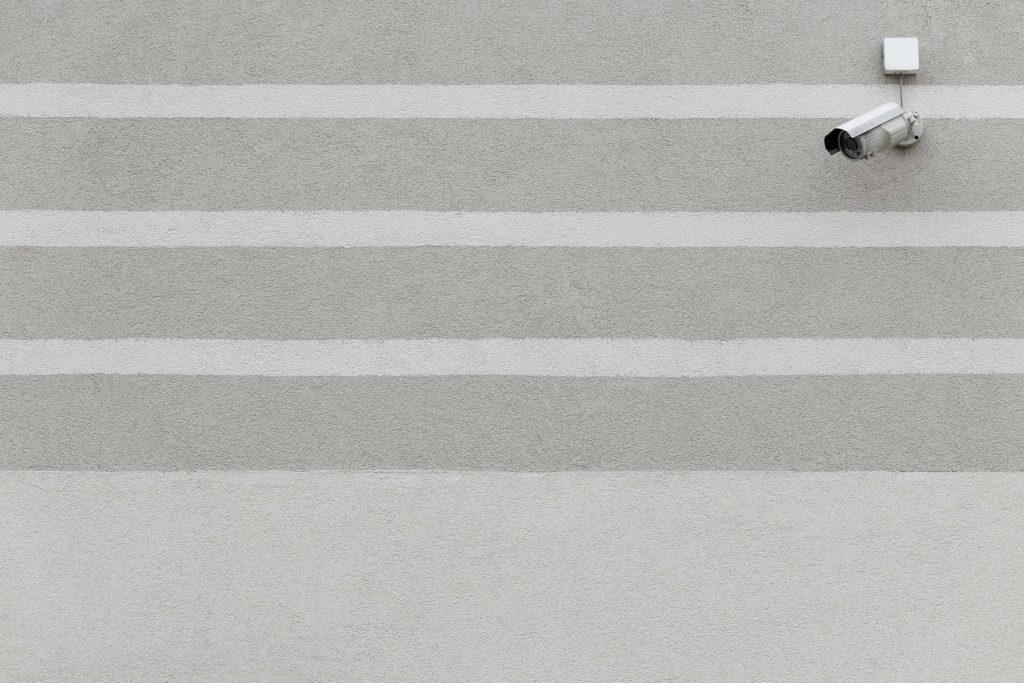How Layered Vision Became the Future of Video

Not long ago, the PTZ functionality, megapixel count and hard technical specs alone might have made an impressive camera system. The more clearly one could see an individual and track their movement, the better. Bonus points were awarded for efficiently transmitting and storing the footage.
However, clear video is often not enough to impress today. Nothing has exposed this fact more than the COVID pandemic and the unique problems it has posed to the world.
Now, cameras are needed on a larger scale than ever before and in niche use cases, like more quickly screening people for fever, warning authorities or supervisors of overcrowded areas, and enforcing social distancing.
These problems have required niche ways of using video feeds. In these new applications, more businesses and consumers are seeing the advantages of building layers of analytics and new lenses of interpretation on top of a clear video feed. Just like microprocessors made cell phones a new reality through an enhanced utilization of the technology, advanced video analytics and processing capabilities will create new paradigms for electronic security.
No longer will a simple stream of video do the job; today’s problems require layers of interpretation performed in real time, transforming a normal video feed into raw input for advanced processing and more insightful output. Seeing rich insights in real time displayed on video has been the stuff of science fiction for a long time, but now we have the technology to make that happen.
For example, just to solve the unique problems posed by COVID-19, thermal imaging technology and software for interpreting the sensor’s reading were needed to detect temperatures for screening employees. The ability to clearly see subjects, recognize humans in a video, then recognize their distance from one another were required for enforcing social distancing. These solutions would not be possible without clear video, advancements in artificial intelligence and enhancements to both onboard processing and server-side software – all of which combine to form a “layered vision.”
The technology has been here quietly for some time, building layer by layer on previous advancements. We will begin seeing more and more novel solutions soon as people realize the power gained by taking a step further into the possibilities of seamless, intelligent uses for video.
But before we look to the future, we need to understand how layered vision took center stage.

Video Heats Up
When COVID struck, many companies wanted a quicker way to screen employees. Temperature detection solutions sprung up to repurpose existing thermal imaging technologies. Some companies started implementing these solutions, and the FDA and other organizations made statements about the efficacy and legal implications of the technology’s use for these purposes.
Integrators were on the fence about offering temperature detection solutions. What companies would this solution work for? What environment was needed for accurate readings? What support would they need?
Everyone naturally wanted to help during the unexpected global pandemic, but the path forward for temperature detection solutions was just as unclear as everything else at that time. Some believed the technology wasn’t mature enough yet and, wary of offering an unstable solution, decided not to offer temperature detection setups. Others found suppliers they trusted and began setting up systems for larger companies that needed them, although often these integrators had to invest considerable time into research and testing the solutions before they were comfortable offering them.
“I started studying and researching thermal imaging technology before I got into the human body temperature and it just kind of fell into place. I had been working with thermal imaging for a few months, then this all happened and it was the perfect timing to be in on it early,” says David Morris, president of Modern Systems, Inc. “So we researched several different manufacturers and quickly dismissed what I felt was cost prohibitive, number one, and number two: not available. Nobody cared who was interested in anything that was 30 to 60 days out. Anybody who was interested, they needed it right then.”
After finding a supplier, the company still had to comply with the relevant regulations, provide the education needed by the customers and supply the training needed by staff in the integration company. The list of caveats and limitations on the technology, combined with the preference by governing bodies for handheld thermometers to be the true determinant of temperature, meant that the systems were not going to be popping up in just any business. The costs were enormous, and for the most part only larger companies were able to justify the purchase of temperature detection systems.
Despite these many challenges, Morris reported that the systems his company installed have received positive reviews. He did not, however, advise other companies to begin selling these solutions if they do not already offer them.
“A few months ago, we didn’t realize anything like this was on the market. We found the technology to be highly accurate. But the first system that we installed was in our own operation, on our own offices. So, if you don’t do that, I don’t think I’d want to be a dealer trying to figure it out,” says Morris. “It’s a significant commitment in time and money for a company to decide to get in. I think it would be disastrous for most any company that attempted to just try it during this wave.”
…advanced video analytics and processing capabilities will create new paradigms for electronic security.
Reignited through Repurposing
Understanding that this takes a significant commitment, many integrators might still wonder what future demand for this technology will look like. Will companies need to screen for a fever again after this unprecedented situation? Would the advantages of temperature detection systems during a year without a pandemic outweigh the costs of the underlying technologies? Will more specialized use cases become popular?
“I think the long–term relevance is going to be in critical care situations, whether it be nursing homes or even possibly schools. I think these will be designed into systems in the future,” says Morris. “Now, how that goes, I don’t know. That’s just a guess. Once the sense of urgency is over and life returns to normal, I’m just not confident that you’re going to see a high demand for this technology.”
A new solution gaining prominence as fears around COVID wane is one that has been used by retail stores for years: people counting. With certain software configurations, existing cameras can be repurposed to not only count occupants but to alert users if customers, students or employees are moving too closely together.
“I would imagine that sooner or later schools will budget for some of this technology. We’ve put counting cameras in a couple manufacturing plants and one store. I think the ship has sailed for now, but if this thing spikes in the fall like they predict, companies will be back on the hunt again. We’ll have to give it a year,” says Chris Mosley ESA president.
Companies are racing to fill the gap in social distancing enforcement with video solutions as well as repurposed access control solutions, rather than requiring participants to use their smartphones – which are synonymous with their virtual identities. These companies propose the use of wireless tags or chips that students could clip onto their backpacks, for example, which would keep a log of their distance from other students as an additional means of contact tracing.
The overlap here between contact tracing, access control and people counting technologies speaks volumes about the role our industry plays in protecting people beyond just intruders or fires. The electronic security industry is uniquely positioned to use our technologies to defeat this new threat and prepare for the future.
This overlap also shows another example of the potential of layered vision: surveillance cameras could confirm or deny what the wireless tags reported. They could also be used in conjunction with the tags to prevent the need for facial recognition software, which often gives pause to many parents with privacy concerns. Theoretically, by combining the location information of the wireless tags with the information from an intelligent video system, administrators could see in real time which tag was where, using the tags as an identifier rather than the students’ faces.
Accelerating the Evolution of Video
I predict that as video solutions requiring layers of interpretation become more popular, the market will begin to shift toward product ecosystems that interconnect on both a hardware and software level. The layers building one on top of another will result in specializations beyond what already exist, as we have seen in software companies and countless other markets before. The cycle will continue with a period of patchwork specialized solutions, then bundled versions that are more streamlined, until the next disruption comes along and it all starts over.
In the next step of the layered video revolution, a camera that just shows video will be akin to an alarm that simply sounds. How the system interprets the video and what it can activate will be of more interest. Edge computing advancements will allow cameras to perform their own interpretation before sending the rich data to be combined with data from the rest of the device ecosystem.
We will quickly move beyond simple motion detection or people counting, and into advanced sequences of events and rich insights. To that end, one manufacturer’s camera that detects temperature might be expected to interface with another manufacturer’s access control system. A facial recognition software might be expected to interface with a home lighting system to set the lights to a user’s preferences. A surveillance camera might be expected to connect to a location system to improve efficiencies in a warehouse.
The possibilities are as endless as they are challenging. Now that the industry and markets have seen a sudden emergence of use cases for layered vision, video is poised to evolve rapidly.




